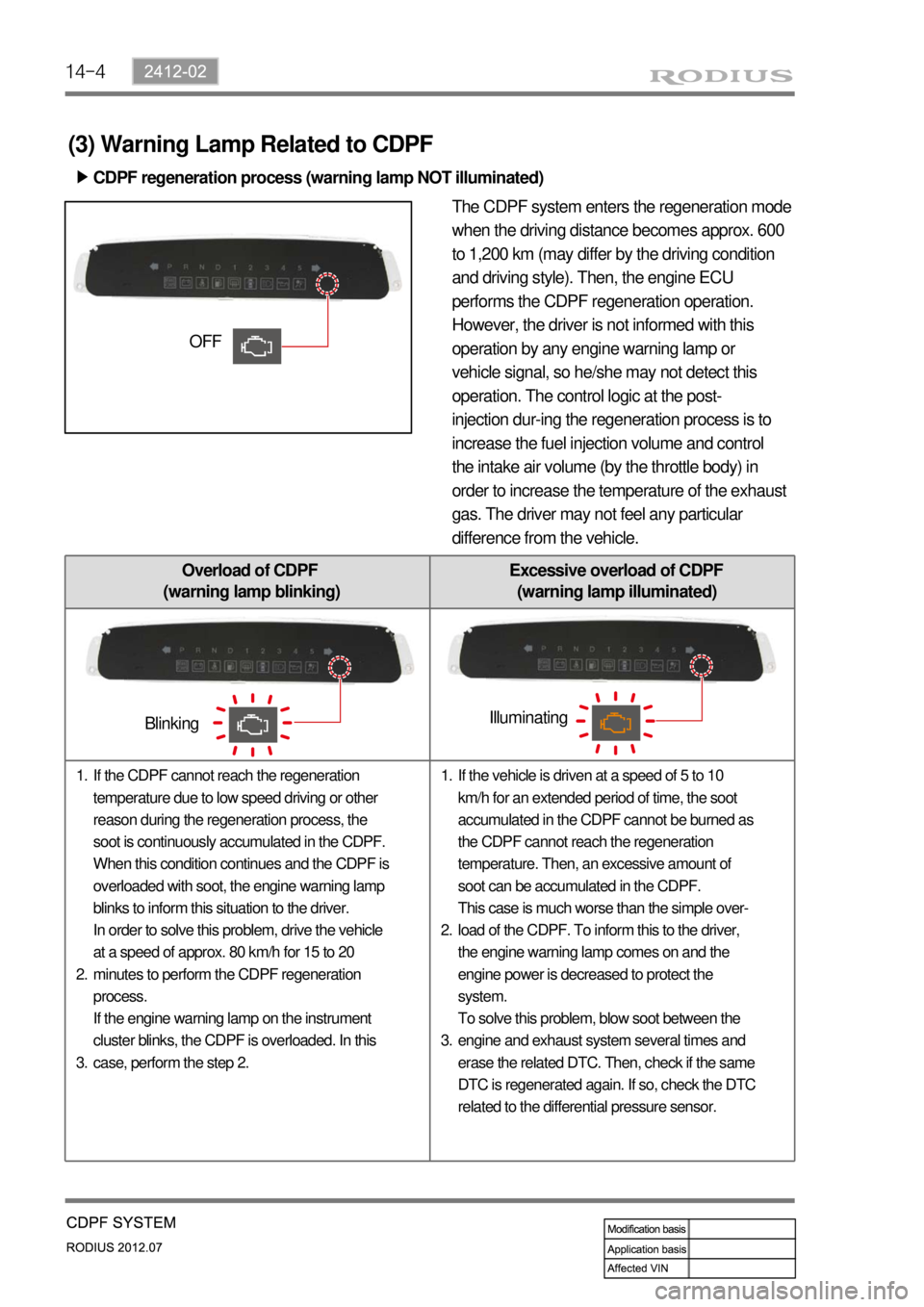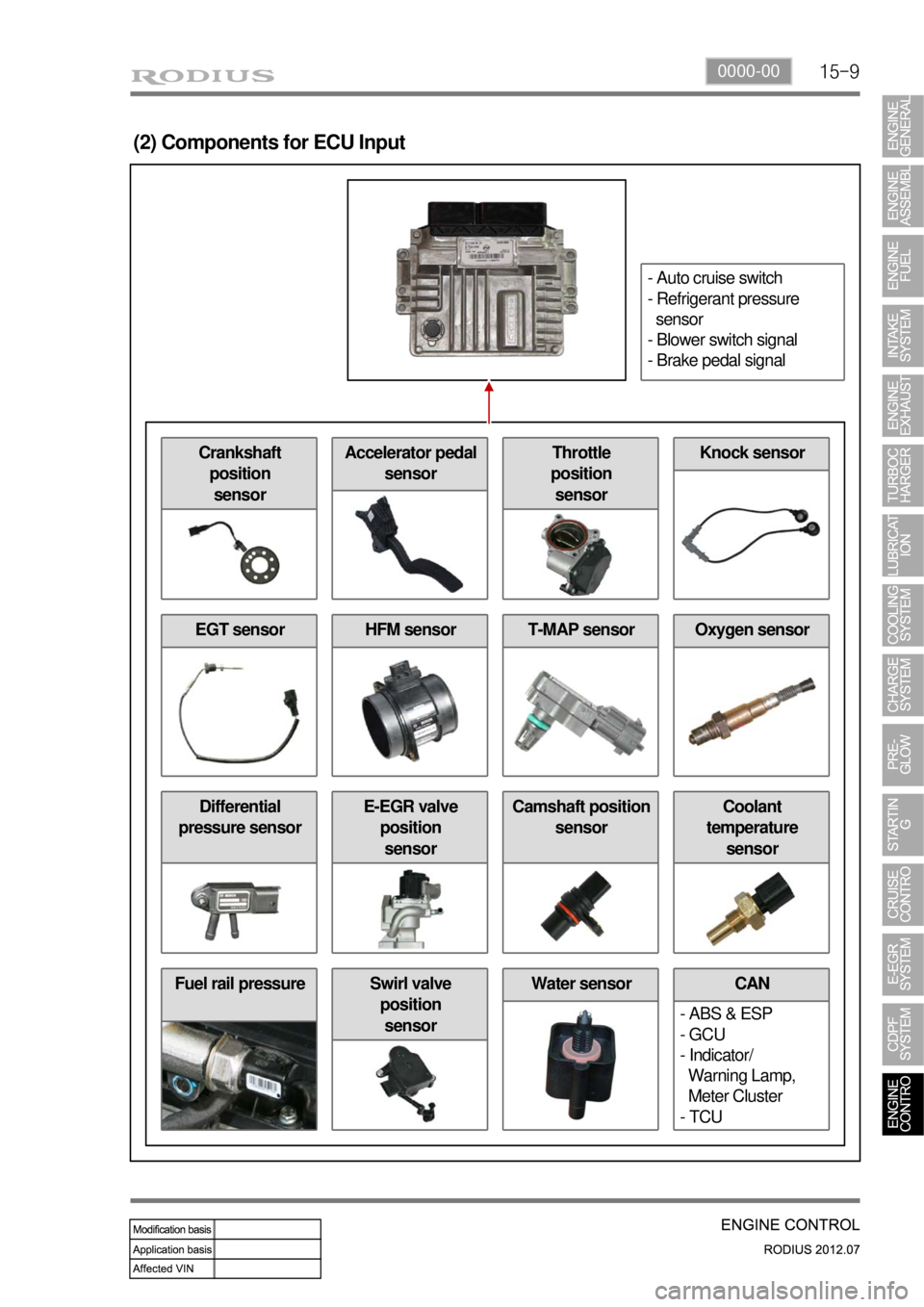differential SSANGYONG RODIUS 2012 Service Manual
[x] Cancel search | Manufacturer: SSANGYONG, Model Year: 2012, Model line: RODIUS, Model: SSANGYONG RODIUS 2012Pages: 715, PDF Size: 79.36 MB
Page 164 of 715

02-70000-00
3. CHECK AND INSPECTION
1) Cylinder
(1) Compression pressure test
Specified value ▶
Compression ratio16.5 : 1
Test conditionat normal operating temperature (80˚C)
Compression pressur
eStandard32 bar
Minimum18 bar
Differential limit between cylindersMaximum 3 bar
The compression pressure test is to check the conditions of internal components (piston, piston
ring, intake and exhaust vale, cylinder head gasket). This test provides current engine operating
status.
Measurement ▶
<007e0088009900940047009b008f008c0047008c0095008e00900095008c0047009c00970047009b00960047009500960099009400880093004700960097008c00990088009b00900095008e0047009b008c00940097008c00990088009b009c0099008c00
47004f005f005700b6006a00500055>
Disconnect the fuel rail pressure sensor connector to cut off the fuel injection.
Remove the air cleaner duct and glow plugs. -
-
-
Place the diagram sheet to compression
pressure tester and install it into the plug
hole. 1. Before cranking the engine, make sure that the test wiring, tools and persons are keeping
away from moving components of engine (e.g., belt and cooling fan).
Park the vehicle on the level ground and apply the parking brake.
Do not allow anybody to be in front of the vehicle. -
-
-
Page 314 of 715

14-4
Overload of CDPF
(warning lamp blinking)Excessive overload of CDPF
(warning lamp illuminated)
(3) Warning Lamp Related to CDPF
CDPF regeneration process (warning lamp NOT illuminated) ▶
The CDPF system enters the regeneration mode
when the driving distance becomes approx. 600
to 1,200 km (may differ by the driving condition
and driving style). Then, the engine ECU
performs the CDPF regeneration operation.
However, the driver is not informed with this
operation by any engine warning lamp or
vehicle signal, so he/she may not detect this
operation. The control logic at the post-
injection dur-ing the regeneration process is to
increase the fuel injection volume and control
the intake air volume (by the throttle body) in
order to increase the temperature of the exhaust
gas. The driver may not feel any particular
difference from the vehicle.
If the CDPF cannot reach the regeneration
temperature due to low speed driving or other
reason during the regeneration process, the
soot is continuously accumulated in the CDPF.
When this condition continues and the CDPF is
overloaded with soot, the engine warning lamp
blinks to inform this situation to the driver.
In order to solve this problem, drive the vehicle
at a speed of approx. 80 km/h for 15 to 20
minutes to perform the CDPF regeneration
process.
If the engine warning lamp on the instrument
cluster blinks, the CDPF is overloaded. In this
case, perform the step 2. 1.
2.
3.If the vehicle is driven at a speed of 5 to 10
km/h for an extended period of time, the soot
accumulated in the CDPF cannot be burned as
the CDPF cannot reach the regeneration
temperature. Then, an excessive amount of
soot can be accumulated in the CDPF.
This case is much worse than the simple over-
load of the CDPF. To inform this to the driver,
the engine warning lamp comes on and the
engine power is decreased to protect the
system.
To solve this problem, blow soot between the
engine and exhaust system several times and
erase the related DTC. Then, check if the same
DTC is regenerated again. If so, check the DTC
related to the differential pressure sensor. 1.
2.
3.
OFF
BlinkingIlluminating
Page 316 of 715

14-6
Differential Pressure Sensor
Calculates the amount of PM
collected by reading the pressure
difference between pre-CDPF and
post-CDPF.Engine ECU (D20DTR)
Post injection
Electric Throttle Body
Regulates the air intake
rate.CDPF
(DOC+DPF)Front EGT Sensor
Measures the combustion
temperature.
Rear EGT Sensor
Measures the CDPF
temperature.
2. COMPONENTS
For details, refer to section "Engine Control". *
Page 317 of 715

14-72412-02
3. INPUT/OUTPUT DEVICES
Front temperature sensor: This sensor is installed at the inlet of DOC and detects whether the
DOC can burn (oxidize) the post-injected fuel or not.
Rear temperature sensor: This sensor is installed at the inlet of DPF and monitors that the
temperature of the exhaust gas is kept at 600℃. 1.
2.
<0070008d0047009b008f008c0047009b008c00940097008c00990088009b009c0099008c0047008c009f008a008c008c008b009a0047005d005700570b4500530047009b008f008c004700930090008d008c00470096008d0047006a006b0077006d004700
8a0088009500470089008c00470099008c008b009c008a008c>d. So the amount of fuel
post-injection is decreased.
<0070008d0047009b008f008c0047009b008c00940097008c00990088009b009c0099008c0047008b009900960097009a0047009c0095008b008c00990047005d005700570b4500530047009b008f008c004700990088009b008c00470096008d0047009900
8c008e008c0095008c00990088009b0090009600950047008a>an be decreased. So the
amount of fuel post-injection is increased. -
-
Differential pressure sensor: This sensor checks the amount of PM collected by calculating the
pressure difference between before and after the CDPF.
Electric throttle valve: This valve reduces the intake air flow to raise the temperature of the
exhaust gas when the CDPF is operating during idling. 3.
4.
Page 318 of 715

14-8
4. POST-INJECTION AND AIR MASS CONTROL
A DPS (Differential Pressure Sensor) measures the pressure difference between before and after
the CDPF and detects whether the soot is collected in the CDPF or not. If PM is collected in the
CDPF (In this case the pressure difference between before and after the CDPF exceeds the
specified value. Normally, the system sends the signal when the driving distance becomes approx.
600 to 1,200 km), the temperature of exhaust gas is increased and the post-injection is started for
regeneration. The amount of fuel post-injection is controlled by the exhaust gas temperature
<0094008c0088009a009c0099008c008b0047008900a00047009b008f008c00470099008c008800990047009b008c00940097008c00990088009b009c0099008c0047009a008c0095009a00960099005500470070008d0047009b008f008c0047009b008c00
940097008c00990088009b009c0099008c00470090009a0047>less than 600℃, the amount of
post-injection is increased to increase the regeneration temperature. Otherwise, the fuel injection
amount is decreased or the fuel is not injected.
When the engine is running with low load, the intake air amount is also controlled as well as fuel
injection amount. This function is used to increaser the combustion temperature by increasing the
amount of fuel post-injection with the lowest air amount within the specified control logic.
Page 319 of 715

14-92412-02
Rear temperature sensor
Measure the outlet
temperature of DOC.
This sensor is located at
the rear side of DOC and
monitors the overheating of
CDPF and post injection
volume.
Differential pressure sensor
Measures the difference between
inlet and outlet pressures of
CDPF.
If the difference is higher than the
specified value when collecting
the PM, this makes the post
injection for forced recycling of
PM.
Front temperature sensor
Measures the temperature of
exhaust gas.
This sensor is located at the rear
side of exhaust manifold and
monitors the temperature of
combusted gas to prevent the
exhaust system from overheating.
When the temperature gets
higher, this sensor cuts off the
fuel delivery and controls the EGR
to lower the temperature.
Engine ECU (D20DTR)
T-MAP sensorIntake air
mass
Measures
the
excessive
amount of
PM.
Injector (C31)
Controls the post injection.
Electric throttle body
Controls the intake air
mass.
HFM sensor
Wide band
oxygen
sensor
Boost
pressure/
temperature
Page 320 of 715

14-10
Collecting PM
→ Regeneration
The engine ECU detects the
amount of PM collected by
the information from the
temperature sensors and
differential pressure sensor.
When the soot is
accumulated, the engine ECU
performs post-injection to
increase the exhaust gas
temperature and burns the
collected PM at approx.
600°C.Oxidation (DOC)
When the exhaust gas enters
into the CDPF assembly, its
CO, HC and PM are reduced
by the redox reaction of the
DOC. The remaining PM is
filtered and collected in
CDPF, and the temperature of
the exhaust gas is increased
to between 450 and 500°C.
5. OPERATING PROCESS
[Configuration and principle of operation]
The exhaust gas
passed through the
exhaust manifold
enters into the CDPF
assembly (at approx
250℃).
Page 323 of 715

14-132412-02
3) PM Regeneration of DPF
The differential pressure sensor installed in the DPF measures the pressure values of inlet and
outlet of CDPF. And the amount of the PM collected in the filter is calculated based on the exhaust
temperature, intake air mass flow, booster pressure, etc.
The regeneration is started when the amount of the collected PM is 28 g or more.
<007b008f008c0047006c006a007c0047008a00960094009400880095008b009a004700970096009a009b0054009000950091008c008a009b0090009600950047009b0096004700900095008a0099008c0088009a008c0047009b008f008c0047009b008c00
940097008c00990088009b009c0099008c00470096008d0047>CDPF to 600℃.
When the amount of the collected PM is not enough: The DPF works as a filter. 1.
When enough amount of PM is collected: The ECU commands post-injection and increase the
exhaust gas temperature to start regeneration. 2.
Page 331 of 715

15-6
Fuel Rail Pressure SensorFront EGT Sensor
Differential Pressure SensorCamshaft Position SensorRear EGT Sensor
Page 334 of 715

15-90000-00
Fuel rail pressure Water sensor
(2) Components for ECU Input
CAN
- ABS & ESP
- GCU
- Indicator/
Warning Lamp,
Meter Cluster
- TCUSwirl valve
position
sensor
Differential
pressure sensorE-EGR valve
position
sensorCamshaft position
sensorCoolant
temperature
sensor
EGT sensorHFM sensorOxygen sensorT-MAP sensor
Crankshaft
position
sensorAccelerator pedal
sensorThrottle
position
sensorKnock sensor
- Auto cruise switch
- Refrigerant pressure
sensor
- Blower switch signal
- Brake pedal signal